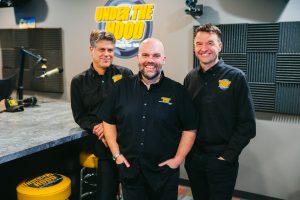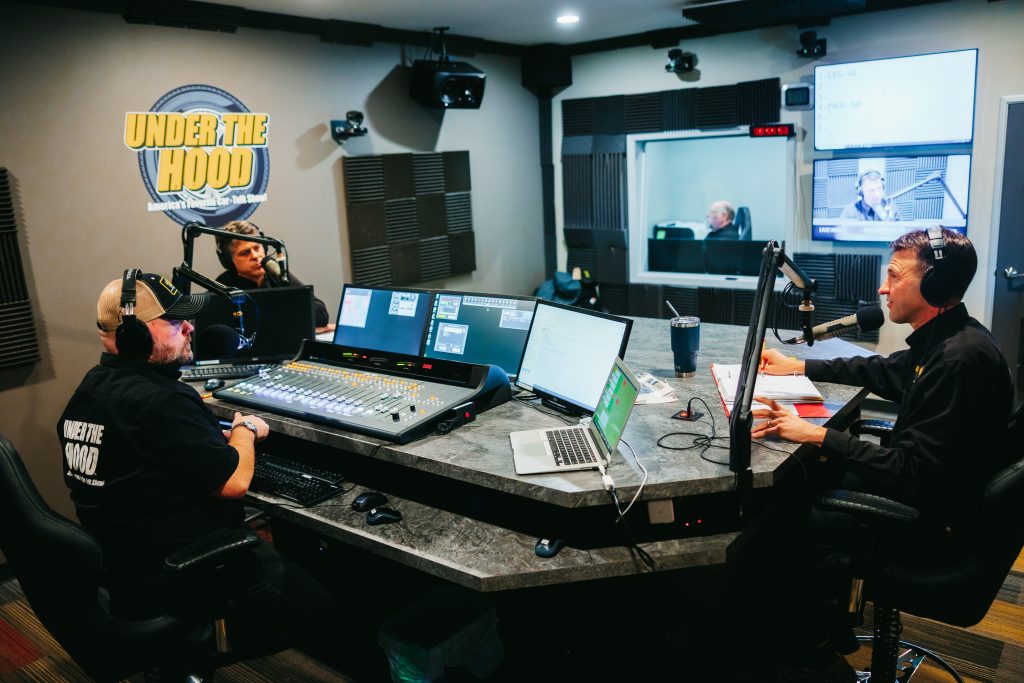Under The Hood
The makings of America’s most popular car talk radio show
Russ Evans was working as an automotive electrical specialist in Sioux Falls, South Dakota when he first met Shannon Nordstrom, who was helping to run his family’s auto recycling business. “Shannon was talking with our mutual friend Ron Sabers and asked him if he knew anyone who could help one of his customers fix up a Lexus that had been in a flood—and Ron connected us,” Evans recalls. After that repair, Evans stayed in touch with Nordstrom, helping him with client projects before going on to work at Nordstrom’s shop. Shortly thereafter, Nordstrom asked Evans if he’d like to join his efforts around a different venture—Under The Hood, the weekly car talk radio show he had been hosting.
“Shannon said that the calls were getting more technical lately and asked if I’d want to come down one week and give it a go,” says Evans. After that one time, Evans made a mark—when he wasn’t there the following week, a listener called in asking where the “supertech” guy was. From that point on, Russ “Supertech” Evans joined Nordstrom for the show every week, and five years later, broadcasting veteran Chris Carter completed the team. “Chris loves cars and loves hearing about them, but he’s not a mechanic—so he keeps us from getting too technical,” says Evans.
“If we have a week where one of us isn’t there, it’s just not the same—we all have a lot of fun together.”
The group’s lively dynamic and thoughtful tips have helped to grow the show exponentially over the years, today airing on its own podcast and more than two hundred fifty AM and FM stations across the country (with many of those affiliate stations facilitated by the late Vic Jacquot, longtime listener and friend). When the trio gathers and opens the call lines, they receive upwards of 20 inquiries spanning the automotive realm, covering everything from best practices in insuring cars, how to care for new drivers in the family, and what to consider regarding warranties, used car inspections, safety recalls, and beyond.
“We’ll get a call about one thing, which will prompt more people to call in,” says Evans, noting the example of someone calling with a question about their Mustang following someone’s call about their 60s Pontiac GTO. And those types of classic car inquiries, Evans notes, have been increasingly on the rise—a trend he partially attributes to the pandemic.

“We’ve been taking more calls the past three years on collector and muscle cars than ever before. To us, it seems that the pandemic sparked automotive hobbies for many, including parents and their children,” says Evans. When it comes to the shop, the team has also noticed an increase in parts requests for engine swap conversions and other restoration jobs—and a younger demographic behind them. “We’re seeing a number of individuals in their twenties and thirties getting into these street rod, muscle car, and four-door classic projects—older Impalas and Chevys; a new fuel injected engine for their 70s Camaro. Classic cars are becoming iconic to younger people. We’re really seeing the market take off.”
Those kinds of inquiries have been so popular that the team started “Berkley One Classics: Guess the Color of the Car,” a part of the show when Evans, Nordstrom, and Carter all take their best guess on the hue of a caller’s collector vehicle.
“For a while, Shannon was winning all of them, but now we’re pretty evenly matched,” laughs Evans, who notes that the game has also invited opportunities for special audience feedback. “We’ve had a lot of our listeners say things like, ‘When you all were guessing the color of that caller’s 1967 GTO, I remembered the red 1967 GTO I had when I was younger—the one I just knew had to be red. It brought me back to those times.’”
It’s those moments of connection and nostalgia that continue to drive Evans and team to produce and grow the weekly show. Evans said:
“Shannon, Chris and I are very different people, but we all love cars, and we try to share that love of cars with people. It’s important to us that others take an interest in the classic car market and the hobby of cars—to get them asking questions and involved in the community. Cars are more than transportation—they become a canvas as we become artists who customize them. They’re a way of connecting us all.”

Here, Evans shares key learnings from the show’s decades-long success, from those rooted in resilience to relationship.
Never give up
Today, Under The Hood is the largest car talk radio show in the nation, but getting there wasn’t always an easy journey. “We like to say that it only took us 30 years to become an overnight success,” says Evans, who references previous roadblocks the team faced—including syndication deals that fell through and the need to switch stations to keep their Thursday time slot. “You’ll fail 100 percent of the time if you give up—but if you don’t give up, you’re going to have wins, one at a time,” he says. “We’re still working at it, and we’ll keep going as long as we can.”
Listen to everyone
Evans credits much of the team’s success to their willingness to factor in everyone’s take. “Everyone out there is important, and everyone’s ideas are important,” he says, referencing the times he has thought about passing up the ideas of others on the show. “When I have taken their advice, it’s almost always a success in some small or huge way—just because I listened to them.”
Be kind
More than anything, Evans emphasizes the importance of kindness—in customer service and beyond. “At one point, Shannon connected me with someone in California who wanted to start his own car talk radio show with a couple of guys and wanted to know how to do it,” says Evans. “They had success for a few years, and when the show wrapped up, he called me saying, ‘Hey Russ, I told you I’d pay you back someday—there are more than 140 stations now looking to fill our spot, and I’d like to connect you with them.’” That assist led to more than 100 stations for Under The Hood, contributing significantly to the show’s growth—and helping Evans to remember the power of relationship. “Always treat the people you encounter well, and pay attention to what their needs are, even if it turns out to be a non-profitable situation,” he says. “They’ll remember you, and they’ll come back to you.”
—
Want even more One Adventures? Read our other issues: Issue 01; Issue 02; Issue 03; Issue 04; Issue 05; Issue 06; Issue 07.
Berkley One is a Berkley Company.



